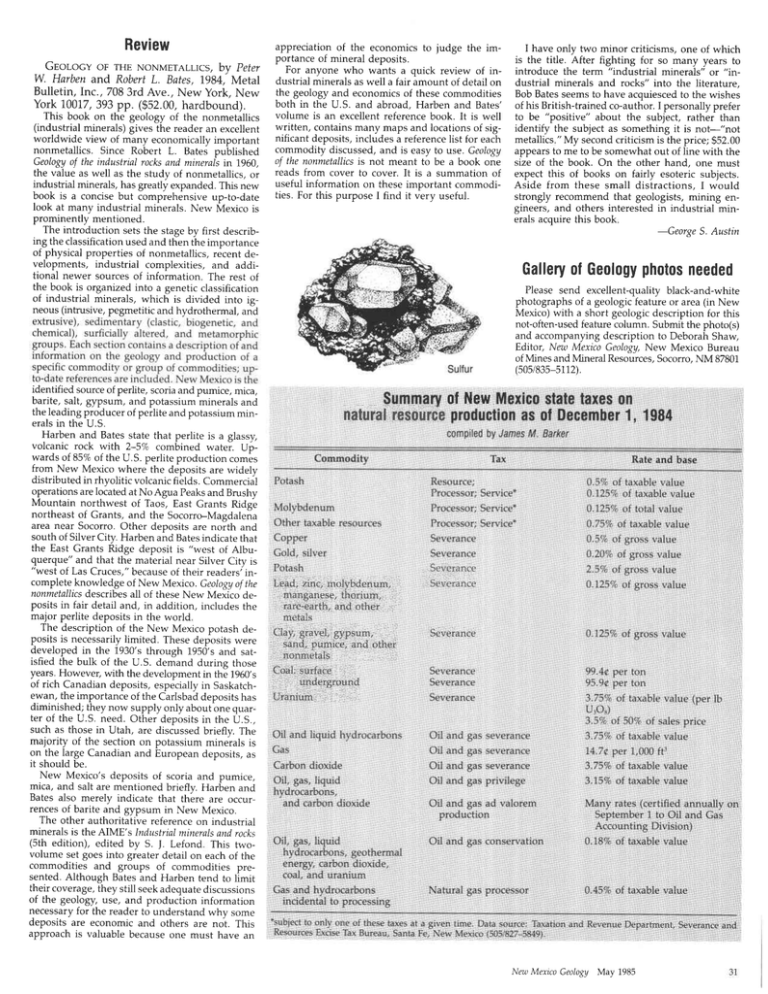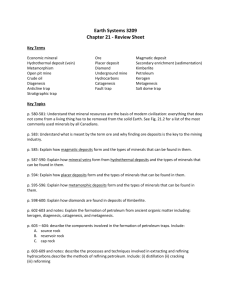Review
advertisement

Review Grolocy oF THENoNMETALLTcs, bv Peter W. Harbenand RobertL. Bates,1984,Metal Bulletin, Inc., 7083rd Ave., New York, New York 10017,393 pp. ($52.00,hardbound). This book on the geologyof the nonmetallics (industrial minerals) gives the reader an excellent worldwide view of many economically important nonmetallics. Since Robert L. Bates published Geologyof the industrial rocksand minerals in 1960, the value as well as the studv of nonmetallics. or indushial minerals, has greatly expanded. This new book is a concise but iomprehensive up-to-date look at many industrial minerals. New Mexico is prominently mentioned. The introduction sets the stage by first describing the classification used and then the importance of physical properties of nonmetallics, recent developments, industrial complexities, and additional newer sources of information The rest of the book is organized into a genetic classification of industrial minerals, which is divided into ieneous (intrusive, pegmetitic and hydrothermal, and appreciation of the economics to judge the importance of mineral deposits. For anyone who wants a quick review of industrial minerals as well a fair amount of detail on the geology and economics of these commodities both in the U.S. and abroad, Harben and Bates' volume is an excellent reference book. It is well written, contains many maps and locations of significant deposits, includes a reference list for each commodity discussed, and is easy to use. Geology of the nonmetalllcsis not meant to be a book one reads from cover to cover. It is a summation of useful information on these important commodities. For this purpose I find it very useful. I have only two minor criticisms, one of which is the title. After fighting for so many years to introduce the term "industrial minerals" or "industrial minerals and rocks" into the literature, Bob Batesseemsto have acquiescedto the wishes of his British-trainedco-author.I personallyprefer to be "positive" about the sub'iect, rather than identify-the subjectas something it is not-"not metallics " My secondcriticism is the price; $52.00 appearsto me to be somewhat out of line with the size of the book. On the other hand, one must expect this of books on fairlv esoteric subiects. Adide from these small disiractions, I would strongly recommend that geologists, mining engineers, and others interested in industrial minerals acquire this book -George S. Austin photos Gallery ol Geology needed Please send excellent-qualitv black-and-white photographs of a geologic'feature or area (in New Mexico) with a short geologic description for this not-often-used feature column. Submit the photo(s) and accompanying description to Deborah Shaw, Editor, Neza Mexico Geology, New Mexico Bureau of Mines and Mineral Resources, Socorro, NM 87801 (s05/835-5112). identified source of perlite, scoria and pumice, mica, barite, salt, gypsum, and potassium minerals and the leading producer of perlite and potassium minerals in the U.S. Harben and Bates state that perlite is a glassy, volcanic rock with 2-5% combined water. Upwards of 85% of the U.S. perlite production comes from New Mexico where the deposits are widelv distributed in rhyolitic volcanic fields. Commerciil operations are located at NoAgua Peaks and Brushy Mountain northwest of Taos, East Grants Ridge northeast of Grants, and the SocorreMagdalena area near Socorro. Other deposits are noith and south of Silver City. Harben and Bates indicate that the East Grants Ridge deposit is "west of Albuquerque" and that the material near Silver City is "west of Las Crirces," because of their readers'-incomplete knowledge of New Mextco. Geology of the nonmetallics describes all of these New Meiico deposits in fair detail and, in addition, includes the major perlite deposits in the world The description of the New Mexico potash deposits is necessarily limited. These deposits were developed in the 1930's through 195d'sand satisfied the bulk of the U.S. demand during those years. However, with the development in tha 1960's of rich Canadian deposits, especially in Saskatchewan, the importance importanCe of the Carlsbad deposits has diminished; they now supply only about one quarter of the U.S. need. Other deposits deposits in the the U.S U.S., such as those in Utah, are discussed briefly. The majority of the section on potassium minerals is on the large Canadian and European deposits, as it should be. New Mexico's deposits of scoria and pumice, mica, and salt are mentioned briefly. Harben and Bates also merely indicate that thire are occurrences of barite and gypsum in New Mexico. The other authoritative referenceon industrial minerals is the AIME's lndustrial minerals and rocks (5th edition), edited by S. J. Lefond This twovolume set goes into greater detail on each of the commodities and groups of commodities presented. Although Batesand Harben tend to limit their coverage, they still seek adequate discussions of the geology, use, and produciion information necessary for the reader to understand why some deposits are economic and others are noi. This approach is valuable because one must have an of New natulal resourie Lead,zinc, molybdenum, manganese,thorium, rare-earth, and other fii€taIs Clay, gravel, gypsum, sand,pumice,and other nonmetals Coal: surface underground Uranium ,,Seve14nce :l.severrlnci Se.,.erance New Mexico Geology May 1.985




